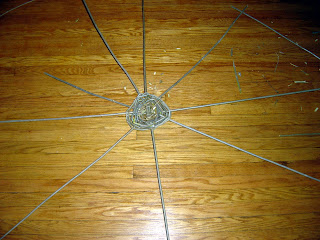As I mentioned in my last post, I decided to go to Eagle Creek Park over the weekend to gather some viburnum. It was our second day of 50F+ degree weather in Indianapolis this year so it was a perfect day for it. There was still a little bit of snow and ice around, but most of it had melted and most of the area I was in was very wet. I was very glad to have brought my rubber boots. I spent a portion of my time standing in 3 inch deep water since that is where a lot of the viburnum was.
My primary goal was to find potential atlatl darts (spears). My theory is that a good arrow wood is also a good dart wood. Viburnum is awesome because it grows straight and long. It doesn't put out branches unless it has reached sunlight, so some of the shoots in the middle of the patch grow 15 feet high or more without any knots or branches. The middle of the patch is where I looked to find my atlatl darts.
While I was looking, I also found some nice arrow shafts. As I trimmed the darts and shafts down to size, I ended up making a pile of thinner pieces. I decided I almost had enough to make a basket. Viburnum is also nice for making baskets because of the long semi-flexible branches. Long material means fewer ends to tuck in when weaving. Some of my basket material was 7 feet long.
At the top is my basket making material. The middle branches will become arrow shafts, and the long ones on the bottom will hopefully become atlatl darts. I will be straightening them as they dry out.

Most of the viburnum was off the main path I was on. I spent over an hour moving from one patch to the next looking for candidate darts. On my little journey I came across a few interesting things. Below is a dead stump that caught my attention. I scraped some chunks off and then ground them up in my palm. It can be used as a coal extender when making fire by friction. For those of you who don't know what I'm talking about, coal extender is basically fuel to keep a coal burning until such time as you can blow it into a flame. I broke off a couple big chunks to take home and try out.

On my way back to the main trail I stumbled across a little metal tin. It was odd because it was covered in camouflage duct tape. I had no idea what it was and the scout in me was a little nervous since it was camouflaged. Convinced that the park was clear of bombs, I opened it. It was a geocache.
Basically it is a little treasure box that people locate with a GPS device using coordinates posted on geocaching.com. People take and leave trinkets and sign the booklet. I signed it for fun and noted that I found it without a GPS device to let future seekers know that I'm better than them. :) Just kidding.

There is a navigation trick I've seen in almost every survival book I've read but never tried before. Before I went on my excursion into the viburnum patches, I set it up. I put a stick in the ground and marked the top of the shadow it cast with a small twig. When I came back about an hour later I marked the shadow again with a twig. I then laid a branch so that it intersected both points. This made an east-west line. From there I found north and south. It probably would have helped to have a compass to confirm to myself that this works, but it seemed to be correct based on my understanding of where I was.

Tomorrow I will post pictures of the basket I made when I got home Saturday.














